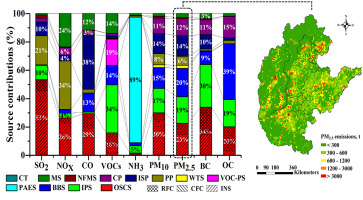当前位置:
X-MOL 学术
›
Atmos. Environ.
›
论文详情
Our official English website, www.x-mol.net, welcomes your feedback! (Note: you will need to create a separate account there.)
A regional high-resolution emission inventory of primary air pollutants in 2012 for Beijing and the surrounding five provinces of North China
Atmospheric Environment ( IF 5 ) Pub Date : 2018-05-01 , DOI: 10.1016/j.atmosenv.2018.03.013 Huanjia Liu , Bobo Wu , Shuhan Liu , Panyang Shao , Xiangyang Liu , Chuanyong Zhu , Yong Wang , Yiming Wu , Yifeng Xue , Jiajia Gao , Yan Hao , Hezhong Tian
Atmospheric Environment ( IF 5 ) Pub Date : 2018-05-01 , DOI: 10.1016/j.atmosenv.2018.03.013 Huanjia Liu , Bobo Wu , Shuhan Liu , Panyang Shao , Xiangyang Liu , Chuanyong Zhu , Yong Wang , Yiming Wu , Yifeng Xue , Jiajia Gao , Yan Hao , Hezhong Tian

|
A high resolution regional emission inventory of typical primary air pollutants (PAPs) for the year 2012 in Beijing and the surrounding five provinces (BSFP) of North China is developed. It is compiled with the combination of bottom-up and top-down methods, based on city-level collected activity data and the latest updated specific emission factors for different sources. The considered sources are classified into 12 major categories and totally 36 subcategories with respect to their multi-dimensional characteristics, such as economic sector, combustion facility or industrial process, installed air pollution control devices, etc. Power plant sector is the dominant contributor of NOX emissions with an average contribution of 34.1%, while VOCs emissions are largely emitted from industrial process sources (33.9%). Whereas, other stationary combustion sources represent major sources of primary PM2.5, PM10 and BC emissions, accounting for 22.7%, 30.0% and 33.9% of the total emissions, respectively. Hebei province contributes over 34% of the regional total CO emissions because of huge volume of iron and steel production. By comparison, Shandong province ranks as the biggest contributor for NOX, PM10, PM2.5, SO2, VOCs and OC. Further, the BSFP regional total emissions are spatially distributed into grid cells with a high resolution of 9 km × 9 km using GIS tools and surrogate indexes, such regional population, gross domestic product (GDP) and the types of arable soils. The highest emission intensities are mainly located in Beijing-Tianjin-Tangshan area, Jinan-Laiwu-Zibo area and several other cities such as Shijiazhuang, Handan, and Zhengzhou. Furthermore, in order to establish a simple method to estimate and forecast PAPs emissions with macroscopic provincial-level statistical parameters in China, multi-parameter regression equations are firstly developed to estimate emissions outside the BSFP region with routine statistics (e.g. population, total final coal consumption, area of cultivated land and possession of civil vehicles) using the software 1stOpt. We find the estimated PAPs emissions of 31 provinces show close correlation with the well-recognized MEIC inventory. This high resolution multi-pollutants inventory provides necessary input data for regional air quality models that could help to identify and appoint the major influence sources, better understand the complex regional air pollution formation mechanism, and benefit for developing the corresponding joint prevention and control policies of regional complex air pollution in North China.
更新日期:2018-05-01



























 京公网安备 11010802027423号
京公网安备 11010802027423号